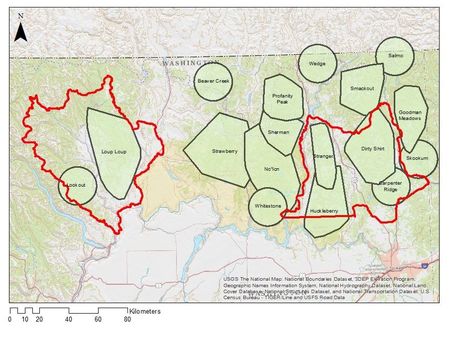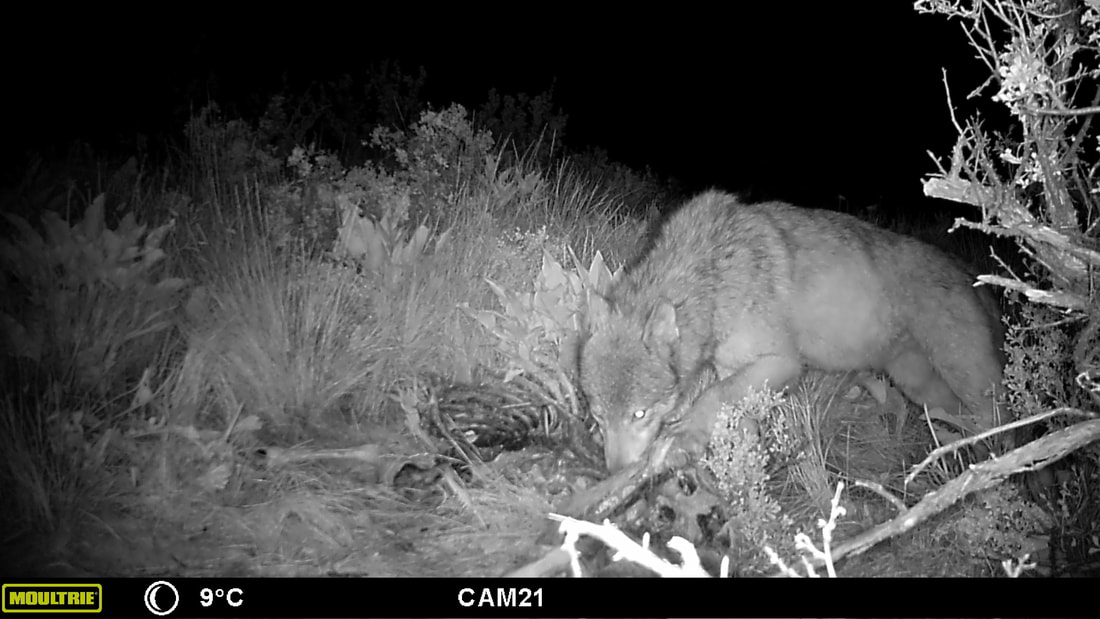
Wolf-Cougar Study Goal: In an effort to understand wolf impacts on mule deer, white-tailed deer, and elk populations, it is critical to also consider the role of cougars, which are currently more widespread and more numerous than recolonizing wolf populations in eastern Washington. Thus, we seek to understand how wolf presence will impact cougar movement patterns and resulting predation on deer and elk.
Methods: We used GPS collars on wolves and cougars to determine if wolves are driving shifts in cougar spatial use. Data collected via GPS collars will also be used to better understand ecological interactions between wolves and cougars that co-occur across a large and dynamic landscape. For example, cougars may move to higher elevations in the presence of wolves. As a result, cougars may decrease predation on white-tailed deer, which reside at lower elevations, and increase predation on mule deer found in higher terrain. Second, we visited wolf and cougar GPS clusters (potential kill sites) to identify patterns in prey selection and kill site spatial distribution (e.g., along elevational gradients) to test whether cougar foraging behavior might change in the presence of wolves. Finally, we are placing camera traps on cougar kills to study whether or not wolves or other scavengers are usurping cougar kills, which would in turn force cougars to spend more energy seeking additional prey.
Study Areas: Our research covers two study areas in eastern Washington, our western 'Okanogan' area and eastern 'Northeast' study area. Each study area is approximately 5,000 km^2 (outlined in red).
The project encompasses six wolf packs in Washington (Okanogan – Lookout and Loup Loup; Northeast – Stranger, Dirty Shirt, Huckleberry, and Carpenter Ridge). The Okanogan study area is being investigated as a colonization front for wolves whereas the Northeast study area is studied as a wolf-saturated landscape with diminishing space for additional packs. Furthermore, the two study areas cover prey breadth as the Okanogan supports predominantly mule deer with smaller populations of white-tail deer, while the Northeast supports predominantly white-tailed deer and elk with smaller populations of mule deer.
GPS Collars: Cougars and wolves reside in both study areas, and GPS collaring efforts for both species commenced in 2016. In total, 60 subadult and adult cougars were collared and monitored across both study areas from 2016-2020. WDFW collared wolves in five of the six study packs.
GPS Clusters and Cameras: We sampled wolf and cougar GPS clusters (potential killsites) in summer (June-September) and winter (December-March) to identify species, age, sex, and body condition of prey. Additionally, collected habitat characteristics at these sites to understand whether and how cougar and wolf foraging patterns differ over a gradient of wolf and human use. When possible, we placed camera traps on cougar kills to capture cougar-cougar, cougar-wolf, and cougar-bear interactions, along with any scavenging activity.
Methods: We used GPS collars on wolves and cougars to determine if wolves are driving shifts in cougar spatial use. Data collected via GPS collars will also be used to better understand ecological interactions between wolves and cougars that co-occur across a large and dynamic landscape. For example, cougars may move to higher elevations in the presence of wolves. As a result, cougars may decrease predation on white-tailed deer, which reside at lower elevations, and increase predation on mule deer found in higher terrain. Second, we visited wolf and cougar GPS clusters (potential kill sites) to identify patterns in prey selection and kill site spatial distribution (e.g., along elevational gradients) to test whether cougar foraging behavior might change in the presence of wolves. Finally, we are placing camera traps on cougar kills to study whether or not wolves or other scavengers are usurping cougar kills, which would in turn force cougars to spend more energy seeking additional prey.
Study Areas: Our research covers two study areas in eastern Washington, our western 'Okanogan' area and eastern 'Northeast' study area. Each study area is approximately 5,000 km^2 (outlined in red).
The project encompasses six wolf packs in Washington (Okanogan – Lookout and Loup Loup; Northeast – Stranger, Dirty Shirt, Huckleberry, and Carpenter Ridge). The Okanogan study area is being investigated as a colonization front for wolves whereas the Northeast study area is studied as a wolf-saturated landscape with diminishing space for additional packs. Furthermore, the two study areas cover prey breadth as the Okanogan supports predominantly mule deer with smaller populations of white-tail deer, while the Northeast supports predominantly white-tailed deer and elk with smaller populations of mule deer.
GPS Collars: Cougars and wolves reside in both study areas, and GPS collaring efforts for both species commenced in 2016. In total, 60 subadult and adult cougars were collared and monitored across both study areas from 2016-2020. WDFW collared wolves in five of the six study packs.
GPS Clusters and Cameras: We sampled wolf and cougar GPS clusters (potential killsites) in summer (June-September) and winter (December-March) to identify species, age, sex, and body condition of prey. Additionally, collected habitat characteristics at these sites to understand whether and how cougar and wolf foraging patterns differ over a gradient of wolf and human use. When possible, we placed camera traps on cougar kills to capture cougar-cougar, cougar-wolf, and cougar-bear interactions, along with any scavenging activity.
Scat Collection: We collected wolf, cougar, and black bear scats at both wolf and cougar GPS cluster locations, and along roads, trails, and off-trail areas while hiking to and from GPS clusters. Scat was analyzed for vertebrate diets using DNA metabarcoding analysis at the Levi Genetics Lab at the Oregon State University. Scat data will provide information on primary prey species utilized by wolves, cougars, and black bears, in addition to demonstrating seasonal dietary overlap in across the three carnivore species.
Management and Ecological Significance: This study is unique in that it considers the effects of predator-predator competition on ungulate predation patterns by looking at wolf-cougar interactions. Predator-predator interactions are a critical missing link long-overlooked in predator-prey studies, despite having the potential to heavily influence outcomes for prey populations. Furthermore, our research is distinctive in that it is conducted across a patchwork of public and private land with diverse anthropogenic influences (agriculture, livestock production, timber harvest, recreation, urban development, wildlife management areas, etc.). Although wolf-cougar dynamics have been studied in other parts of western North America, providing a valuable set of baseline data, these studies have been conducted predominately on public and protected lands (e.g. Yellowstone National Park). Thus, our research will provide information on wolf-cougar-deer dynamics in an area that is more representative of available habitat in western USA, where human landscape use and wildlife management goals must be considered concurrently.
Results of this study will specifically demonstrate how deer and elk predation in Washington State will be impacted by a growing wolf population. We will report differences in selection of prey age, sex, and species by wolves and cougars across a gradient of wolf saturation. We will highlight how changes in cougar spatial use, resulting from wolf recolonization, will alter predation pressure on deer and elk as wolf populations continue to increase. Furthermore, our work will demonstrate how co-occurrence of apex predators alters landscape use and foraging of both predators in a dynamic anthropogenic environment.
Funding: Washington Department of Fish and Wildlife (WDFW); Seattle City Light Research Grant; National Geographic Society Early Career Grant; WDFW-ALEA Volunteer Cooperative Grant Program, Future Investigators in NASA Earth and Space Science and Technology (FINESST) Research Grant; Conservation, Research, and Education Opportunities International (CREOi) Research Grant
UW Project Leads: Aaron Wirsing (PI - UW), Thomas Newsome (PI - UW & University of Sydney), Lauren Satterfield (PhD Candidate - UW)
Results of this study will specifically demonstrate how deer and elk predation in Washington State will be impacted by a growing wolf population. We will report differences in selection of prey age, sex, and species by wolves and cougars across a gradient of wolf saturation. We will highlight how changes in cougar spatial use, resulting from wolf recolonization, will alter predation pressure on deer and elk as wolf populations continue to increase. Furthermore, our work will demonstrate how co-occurrence of apex predators alters landscape use and foraging of both predators in a dynamic anthropogenic environment.
Funding: Washington Department of Fish and Wildlife (WDFW); Seattle City Light Research Grant; National Geographic Society Early Career Grant; WDFW-ALEA Volunteer Cooperative Grant Program, Future Investigators in NASA Earth and Space Science and Technology (FINESST) Research Grant; Conservation, Research, and Education Opportunities International (CREOi) Research Grant
UW Project Leads: Aaron Wirsing (PI - UW), Thomas Newsome (PI - UW & University of Sydney), Lauren Satterfield (PhD Candidate - UW)



